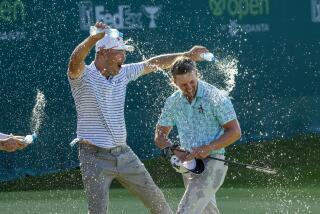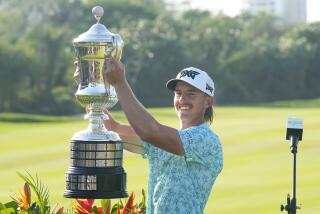Last Year Fills Pavin With Hope : Ex-UCLA Golfer Looking for His Usual Jump-Start
- Share via
INDIAN WELLS — They will be at the first tee. Bob Hope will be on one side, Gerald R. Ford on the other. Between them will stand Corey Pavin. The game is golf and you can just about imagine how two-thirds of the conversation is going to go:
“That’s no bunker, that’s Indio.”
And, “Know who designed these clubs? The joint chiefs of staff.”
What will be Pavin’s contribution? His swing, possibly.
Pavin, the reigning champion of the Bob Hope Chrysler Classic, hopes there’s nothing funny about his swing when he begins defense of his title today. The funny stuff belongs in its proper place, he said.
“I think I’ll leave the humor to the comedians and the politicians,” Pavin said.
The Hope is a five-day event, the first of the eight $1-million tournaments on the PGA Tour. When Pavin won last year, it was worth $162,000 to him. It also started him on his way to a profitable year of touring that did not end until he’d won $498,406.
But as soon as it ended, Pavin put away his clubs. That was on Nov. 15, after the final round of the Isuzu Kapalua when he finished tied for 24th. Pavin went home to Orlando, Fla., and put his swing in mothballs, where it stayed until just two weeks ago, when he began practicing again.
“It was a complete and total vacation,” Pavin said. “I didn’t want to even touch the clubs.”
So he didn’t. And last week at La Costa, well, it kind of showed. Pavin finished tied for 26th at the MONY Tournament of Champions. That from someone who has a reputation as a fast starter. In recent years, Pavin has had a two-stroke lead before the rest of the field is out of the locker room.
Pavin, who skipped the Hope in 1986, won it last year over Bernhard Langer with a birdie on the last hole. After tying for sixth at Phoenix the next week, Pavin won at Hawaii just two weeks later by beating Craig Stadler in a playoff.
Now Pavin is back at the Hope to face a field of 127 other pros, including Curtis Strange, Paul Azinger, Ben Crenshaw and Scott Simpson, the top four 1987 money winners. Play will be on four different courses--Bermuda Dunes, La Quinta, Indian Wells and the Palmer Course at PGA West.
The first 72 holes are a pro-am event with one pro and three amateurs on each team. The low 70 pros and ties will play the final 18 holes Sunday at Indian Wells. By then, Pavin believes his swing will be just about where it ought to be.
“You know, the only person I have to prove things to is me,” he said. “There is probably going to be someone standing beside the green and he’s going to say, ‘Can’t he hit a shot better than that?’ I know I haven’t played very much. But I know I only need to play to improve.
“I’m already starting to play good here and there. I’ve already thrown away about 7 or 8 shots. If I can keep my head together and think and play intelligent golf, I can be in the hunt.”
The hunt. Toward the end of last year, Pavin was in the hunt, all right, hunting for his swing. It had escaped his control. Looking for help, he worked with his teacher, Bruce Hamilton, the pro at Las Posas Country Club in Camarillo. Hamilton, who has been nursing Pavin’s swing since 1975, helped again.
Pavin finished the year with a sixth at Tucson and a tie for fifth at the Nabisco in San Antonio, but he remained unsatisfied with both his swing and the type of year he had.
“I was still fighting the problems I had and I still hadn’t found what I was looking for,” he said. “I was playing with a piston not working. I kept chugging around, but I wasn’t very efficient.
“I had developed a lot of bad habits. Little things. Like I was leaning toward the target at the top of my swing when I should have been perpendicular to the ground.”
Pavin wound up unable to clear his hips properly and found himself unable to swing freely and naturally.
So Pavin took a long time off and has come back swinging. There is only one way to play, he said.
“I play to win,” he said. “I don’t go out there to finish second or third, that’s for sure. The last hole last year was a big turning point for me.”
This is how he won the Hope last year: On the 90th and final hole, Pavin and Langer were even at 18 under par when they walked down the fairway at the rugged PGA West course.
Pavin’s second shot was about 185 yards away from the pin on No. 18 with water on the left. Would he play it safe?
Pavin remembered how he played the last hole at the 1985 Kemper Open. Then, tied with Larry Mize, he didn’t want to get too risky.
“I played the more safe shot to make sure it didn’t go left,” Pavin said. “I was more interested in not making a mistake.”
Pavin wound up finishing second in the Kemper, tied with Mize, both of them a stroke behind Bill Glasson.
“So when I was in that same position last year at the Hope, I didn’t have the same attitude,” Pavin said. “I said to myself ‘See what you can do.’ ”
Pavin went straight at the pin with a 4-iron. Langer missed a four-foot birdie try that squirmed right. Pavin’s 18-footer went straight down.
After five years on the tour, Pavin apparently is taking off. He has already won five tournaments, nearly $1.5 million and he’s only 27. He is also something of a role model to at least some factions of the younger PGA set.
“You never see Corey Pavin doing anything out there except trying to win the tournament,” Azinger said. “He’s not out there safety-valving it.”
On the other hand, though, Pavin admitted that you might not see him out there winning the Hope again. The first time he played it was in 1984, his first event on the tour. He missed the cut. But at Phoenix in his next tournament, it took a final round of 65 and a birdie on the 18th hole by Tom Purtzer to beat him and his closing 68.
“I don’t have to win a tournament to mean that I played well,” he said. “This tournament isn’t easy to do well in, year after year. It’s a tough format--the pro-am--and you have to play rounds of 5 or 5 1/2 hours when you’re used to playing 4 hours. But I feel good about the way I’m playing. The courses are tight, short and tricky and that usually translates into me playing well.
“And believe me, I know when I’m playing well. It’s a feeling I get on the course. I hit a shot. I don’t have to look to know where it went.”
More to Read
Go beyond the scoreboard
Get the latest on L.A.'s teams in the daily Sports Report newsletter.
You may occasionally receive promotional content from the Los Angeles Times.










